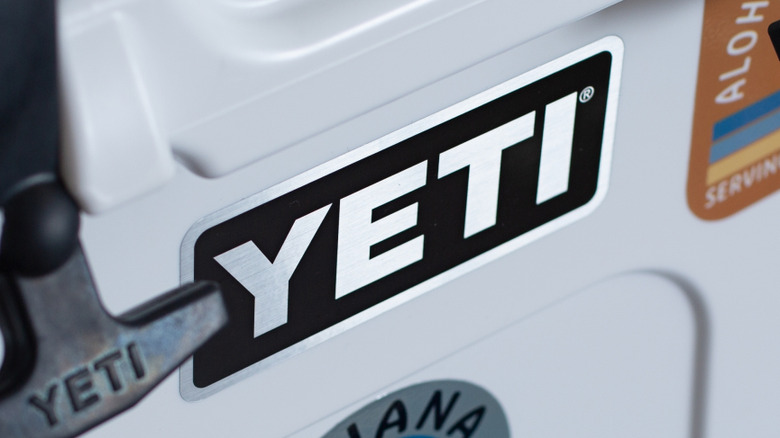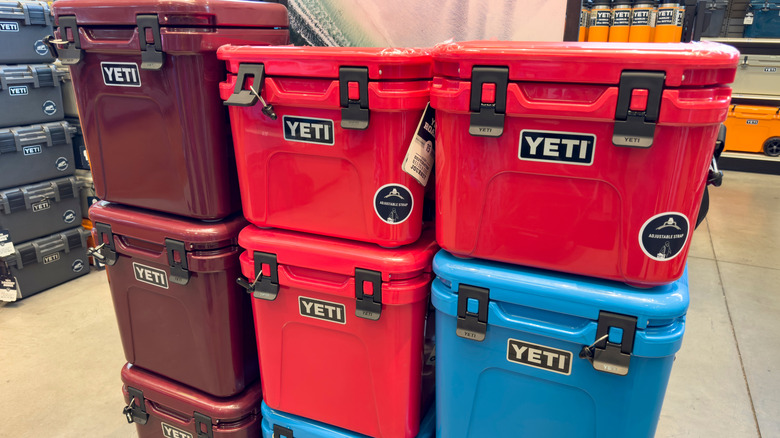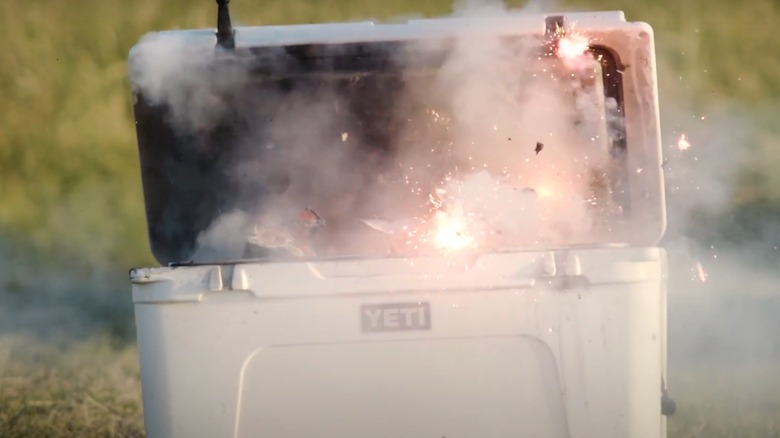Here's What Yeti Coolers Are Made Out Of (And Why They're So Expensive)
The summer months are well and truly upon us, meaning any means of staying cool is welcome. That goes for food and drinks, too, as keeping them out in the heat during a summer barbeque is far from ideal. This is where coolers are essential, and at this stage in the game, there are loads of different ones to consider. There are plenty of benefits to using a smart cooler, though there's nothing wrong with going for something simpler and more traditional. That's where established cooler brand Yeti can help, offering up coolers of all different shapes and sizes to meet your summer outing needs.
Naturally, if you're debating on purchasing a Yeti cooler, you'll want to know what they're made of. As it turns out, the materials they're made from aren't all that uncommon. Yeti coolers are typically made from polyethylene, or plastic, but that's not the most interesting part of their construction. They're created through the process of rotational molding, or rotomolding, which involves rotating material under immense heat. The plastic is placed in a mold, spinning on two axes at two different speeds, and is melted into the right form. The mold is then given the chance to cool, forming a hollow yet durable container for your refreshments. Polyurethane foam is added to act as insulation, retaining the cold within.
Yeti coolers' quality construction greatly contributes to their cost
Compared to the average cooler, it's plain to see that the Yeti brand isn't among the cheaper options. A standard-sized unit can run well over $100, oftentimes costing multiple hundreds, whereas those from competitors like Igloo and Coleman generally don't even reach triple-digits. While one might think consumers are just paying for the Yeti name, this isn't entirely the case. Yeti has become synonymous with quality throughout the years. In fact, speaking with Inc., brand creators Ryan and Roy Seiders cite build quality as a top priority, saying of those who trust Yeti, "All of those groups are willing to pay extra money for products that will last. They wouldn't be caught dead with cheap gear because they identify with quality brands."
From top to bottom, the folks at Yeti seem to want to give customers as much bang for their buck as possible. Their coolers are designed to keep cold, from the roughly three-inch wall of polyurethane pumped into the shell to the freezer-style gasket that keeps the cooler sealed tight. The rotomolding process itself isn't terribly expensive, nor is the plastic particularly special. However, combined, they result in Yeti coolers being impressively durable. The mold process eliminates any potential for uneven wall thickness and ensures strong outer corners, so you don't have to worry about cracks. Some Yeti cooler models can even withstand dry ice.
Yeti takes the matter of durability seriously
Words like "quality" and "durability" can lose their meaning in the world of advertising, as any brand hoping to sell something is likely to toss such words around if it means pulling customers in. In the case of Yeti, the company doesn't mess around when it comes to delivering on such adjectives. Going over to YouTube, Yeti has put together quite an intriguing series of videos demonstrating just how strong its pricey coolers are. While they may not be entirely impervious to damage, they can handle some serious punishment from some wild and unruly sources of abuse for coolers made entirely of plastic.
One of the most remarkable is the Yeti cooler's one-sided battle against a grizzly bear. The massive animal uses its paws, claws, and teeth in hopes of breaking the container, yet the cooler remains strong. By the end of the bout, there are some noticeable signs of damage, but on the whole, the cooler appears to have survived the encounter without falling to pieces. Another extreme example sees the cooler specifically attacked from the inside, being lit up by a barrage of fireworks. The pyrotechnics shake the cooler up and leave it a soot-covered mess by the time the display is over, but it's still in one piece in the end.
There's no denying that Yeti coolers can get expensive. Still, each unit's high construction quality — maintained by the folks who own Yeti and the sites where the coolers are made — certainly helps the case that they're worth the cost.


